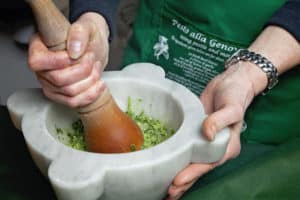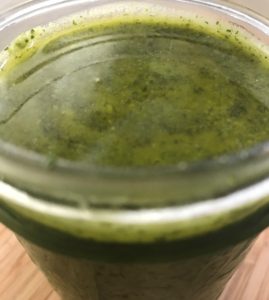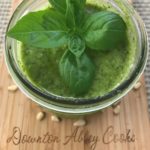Print
Il Pesto, The Original Pesto Genoese Recipe
"Pesto" comes from the Genoese word pestâ, which means to pound or to crush, traditonally using a mortar and pestle to grind basil leaves with the other ingredients. This distinctively green sauce originated in Genoa, Italy's northern region, in the 16th century. Today we use food processors for convenience, but the full release of the aroma basil leaf can only be achieved with the traditional method.
This is the orginal recipe from Genoa. While one of the most popular uses for Pesto is as a pasta sauce, it can also be used as a spread or dip, salad dressing, or as an accompaniment to steak, poultry or fish.
Servings 1 cup
Calories 4028kcal
Ingredients
- 2 cups young sweet basil leaves packed
- 3/4 - 1 cup Parmesan cheese seasoned parmigiano reggiano or grana padano
- 1/4 - 1/2 cup Sardinian pecorino cheese
- 1/2 cup extra virgin olive oil PDO from Liguria
- 1 tsp Sea Salt
- 1/4 cup pine kernels (nuts) from Pisa or the Mediterranean
- 1 - 2 cloves garlic Vessalico garlic is best for its delicate flavour
Instructions
Traditional Method
- Wash the basil leaves, which must be soft and come from plants no more than 2 months old, and dry them carefully on a paper towel.
- Place the garlic into a large marble mortar along with a few grains of salt and begin to crush with the pestle, which should be made of olive tree wood. Add the pine kernels and continue to crush until you get quite a coarse pulp. Add the basil leaves and continue to crush gently, then add the cheese and mix everything together.

- Soften the mixture by adding olive oil, little by little, until it reaches a smooth and creamy consistency, then transfer to a mixing bowl and mix with the rest of the oil using a wooden spoon.
Food Processor Method
- Combine all the ingredients, except olive oil, in a food processor and process until the ingredients are combined. With the machine running, slowly drizzle in the olive oil. Continue processing until the mixture is well blended but still has some texture, pausing to scrape down the sides as necessary.
- Add a pinch of salt to add more zip to the pesto. Use all of the cheese if you’d like a creamier/cheesier pesto.
Storing Pesto
- Pesto can be preserved for a few days in the fridge by covering it with a 1/4" layer olive oil to avoid oxidation, which should then be drained when it comes to be used.

- Pesto is perfect for freezing. Pouring into ice cube trays, and then turned out into Ziploc bags after frozen allows you to add a quick punch of flavour to dishes when you need it.
Notes
Never press the basil leaves too hard, but rotate the pestle gently along the sides of the mortar so that they tear without being crushed. The pesto should be made in mild temperatures and not take too long as oxidation with alter the taste and colour of the basil.
The amount of garlic you use can be altered to suit your personal taste, but leaving it out completely will alter the authentic flavour. Some people, mostly from the Riviera, add a little curd or hazel nuts, which are acceptable additions. Whereas cashew nuts and parsley are an absolute no no!
Where practical, you should avoid using an electric blender as the steel blades and heat produced alter the flavour of the sauce.
One cup is sufficient one pound of pasta. Before adding to the pasta of choice - trofie, troffiette, trenette, mandilli de saea (mini lasagne), testaieu (testaroli) - a good tip is to dilute the sauce a little with the water drained from the pasta.
If you fancy it, you can also boil a few potatoes or string beans with the trenette pasta, to make trenette avvantaggiae, a complete and satisfying typical dish. [nutrition-label]
The amount of garlic you use can be altered to suit your personal taste, but leaving it out completely will alter the authentic flavour. Some people, mostly from the Riviera, add a little curd or hazel nuts, which are acceptable additions. Whereas cashew nuts and parsley are an absolute no no!
Where practical, you should avoid using an electric blender as the steel blades and heat produced alter the flavour of the sauce.
One cup is sufficient one pound of pasta. Before adding to the pasta of choice - trofie, troffiette, trenette, mandilli de saea (mini lasagne), testaieu (testaroli) - a good tip is to dilute the sauce a little with the water drained from the pasta.
If you fancy it, you can also boil a few potatoes or string beans with the trenette pasta, to make trenette avvantaggiae, a complete and satisfying typical dish. [nutrition-label]
Nutrition
Serving: 5g | Calories: 4028kcal | Carbohydrates: 17g | Protein: 145g | Fat: 379g | Saturated Fat: 107g | Polyunsaturated Fat: 35g | Monounsaturated Fat: 224g | Cholesterol: 374mg | Sodium: 12830mg | Potassium: 497mg | Fiber: 1g | Sugar: 2g
